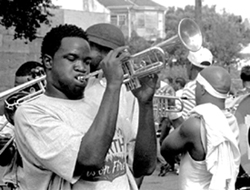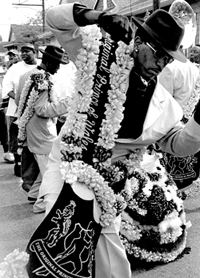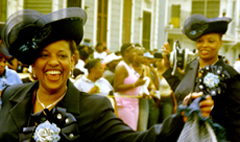New Orleans has a secret: steppers, social clubs, feathered fans, bright sashes and frilled umbrellas.
This is the world just beyond the campus edge, something unknown to the residents of the Ivory Tower.
Few “newbies” and college students know of the deep-rooted traditional second lines that play out in the back streets of New Orleans. They are an integral part of this city beyond the reaches of the Quarter or the Garden District, in small streets and local neighborhoods.
Those aware of second lines know that it is hard to track down where they’ll occur and when. There are no tourists, out of season beads, or phony zydeco at these intimate parades, just well seasoned locals strutting their stuff to big brass bands.
The traditional New Orleans second line plays out like a well-rehearsed script. A local social club sponsors a stepper parade and hires brass bands such as Rebirth or The Hot 8 Brass Band.
Loyola maintenance worker Benny Pete is a tuba player for The Hot 8. He’s been playing for second since the age of sixteen and appreciates this wonderful New Orleans tradition. “It’s great that we’re able to take over the streets for about four hours and the police are there on our side,” he said.
He also describes the routine. The community meets at a corner bar and as the band starts up, members of the social club emerge, decked out regally in jazzy duds.
Umbrellas are touted, suits are fringed and everyone is dressed to the nines. As the parade moves down the street the crowd begins swinging, and the band begins to sweat.
The police show up to aid the clubs by blocking off the roads while everyone moves through. A scheduled route is followed with pit stops along the way for club costume changes and drinks. The parades last two to four hours in the afternoon and everyone remains rowdy despite the long trek.
These parades serve as a living relic to New Orleans colorful past. Web sites such as mardigrasdigest.com offer information on the history of second lines.
Second lines trace back to the early 18th century, as long as brass bands have been around. As tradition goes, a local social club hosts each parade. Each social club chooses a different date and parade route.
These social clubs began long ago as the only companies willing to provide insurance to the African American community.
Once other insurance companies moved in, these clubs concentrated on celebrations and focused in on second lines. The name originated from the formation of the parade. The band that leads the way is referred to as the first line, and following are the dancers, or second lines. And the locals continue to second line through the centuries.
With all of their liveliness and deep-rooted tradition it’s a wonder second lines don’t attract more attention.
However, some students have discovered this hidden jewel. Qian LeBeau, communications sophomore, often attends second line shows.
“I started going (to second lines) when I was a baby on my mother’s hip,” Le Beau said. “Second lines are very fun. The most fun part is watching when new members come out and show their outfits and do a little dance. It can get very crazy.”
However, LeBeau reinforces that second lines can be even more exciting than the French Quarter on a Friday night.
“Sometimes you see people dancing on rooftops,” LeBeau said .

A woman gets in to the second line spirit as she parades down the street followed by members of the Rebirth Brass Band. (Ann Hermes)

A band member plays his trumpet as the dancers congregate in the background. (Ann Hermes)

A new member of a second line troupe ‘steps out’ for the first time wearing an elaborate outfit to accentuate his moves. (Ann Hermes)






